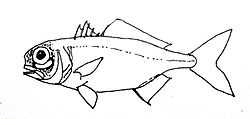Flashlight fish
| Flashlight Fish | |
|---|---|
 | |
| Splitfin flashlightfish, Anomalops katoptron | |
| Scientific classification | |
| Kingdom: | Animalia |
| Phylum: | Chordata |
| Class: | Actinopterygii |
| Order: | Beryciformes |
| Family: | Anomalopidae T. N. Gill, 1889 |
| Genera[1] | |
|
Anomalops | |
The flashlight fish are a family, the Anomalopidae, of beryciform fish. Some unrelated fish with similar features are also called flashlight fish. Notable among these are the deepsea lanternfish, of the family Myctophidae, with over 200 species.
Flashlight fish live in tropical waters across the world. Some species move to shallow waters or coral during the night, but otherwise, they are exclusively deep water fish. They are typically about 14 cm (5.5 in) in adult length, although some species reach twice this size. They feed on small crustaceans.[2] Flashlight fish are named for their large bioluminescent organs. These are located beneath the eyes and contain luminous bacteria. Two methods are used by different species for controlling light emission, either a shutter-like lid is raised over the organ or the organ is turned downward into a pouch. The light is used for predator avoidance, to attract prey, and for communication.[3]
Unrelated "flashlight fish"
Lanternfish sometimes known as flashlight fish include:
- Electrona risso (chubby flashlight fish), found in the eastern Atlantic Ocean and the Mediterranean Sea
- Spotted lantern fish (Myctophum punctatum), found in deep waters of the Mediterranean Sea
References
- ↑ Froese, Rainer, and Daniel Pauly, eds. (2012). "Anomalopidae" in FishBase. October 2012 version.
- ↑ Paxton, John R. (1998). Paxton, J.R. & Eschmeyer, W.N., ed. Encyclopedia of Fishes. San Diego: Academic Press. p. 162. ISBN 0-12-547665-5.
- ↑ Morin, J.G.; et al. (1975). "Light for all reasons - versatility in behavioral repertoire of flashlight fish". Science 190: 74–76.